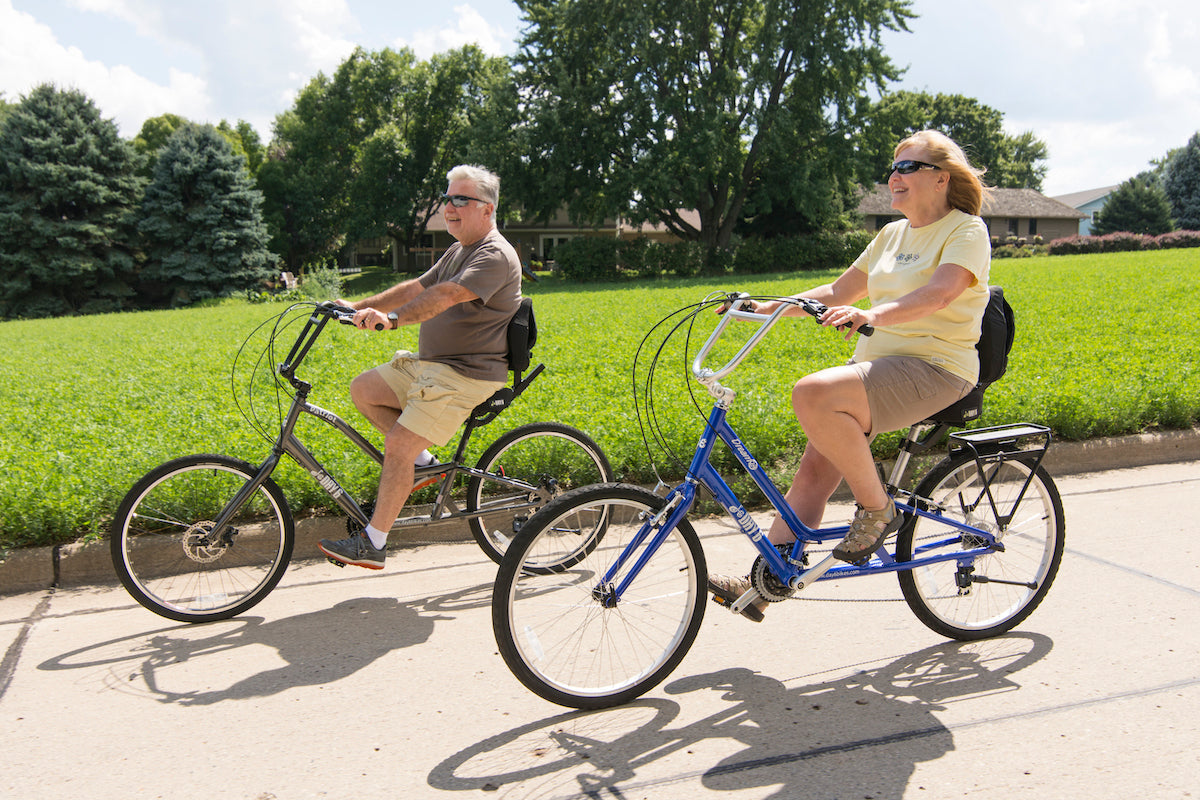The Perfect Bike for the Over 50 Rider

There are multitudes of bicycles for sale on our planet and a myriad of styles as well. There are bikes with skinny tires and bikes with fat tires. There are bikes for racing on pavement and bikes for racing on mountains and gravel. There are upright bikes and recumbent bikes and cargo bikes and BMX bikes. And then there are some categories that are completely confusing like the city bike. Does that mean you can’t ride it in the country? Can you ride a mountain bike in the city? What does that even mean?
 And, it gets more confusing if you are over 50 or have some physical issue that limits your ability to ride a traditional bike - another category.
And, it gets more confusing if you are over 50 or have some physical issue that limits your ability to ride a traditional bike - another category.
Here are some of the more common limiting factors for riders over 50:
- bad back or sore neck, wrists, and/or shoulders
- prostate issues
- overweight/obese
- hip or knee replacement
- general stiffness
- fear of falling/inability to reach the ground with both feet when stopped
- ability to easily get on and off the bike
- the ability to climb hills, keep up with stronger riders, go longer distances
The truth is, many people have given up riding because the last time they rode, it either scared them or hurt them.
Let’s go through a list of specific areas on bicycles that are relevant for the over 50 cyclist or person of any age who relates to the above list of limiting factors.
Handlebars This is where many problems start.
On most bicycles, the handlebars are low and force the rider to lean forward so they can ‘cut’ through the wind. This is advantageous for racing where aerodynamics are critical for speed but, for the casual rider and those with physical limitations, leaning forward puts excessive stress on the lower back, neck, wrists, arms, shoulders, and crotch area/prostate. It just hurts!
The lower back can be especially susceptible because leaning forward engages the powerful quad muscles which can put additional stress on the back.

When leaning forward, the spine is rounded so the neck must hold up the weight of the head while extended back beyond a neutral position. In addition to neck pain, the weight of the upper body is placed on the wrists which are also extended past a natural position.
In addition, leaning over the bars rotates the hips forward, placing extra stress on the crotch/prostate area which can have long term implications. As you can see, leaning forward leads to a long list of positioning challenges for the casual rider.
Ideally, the casual rider wants to be in an upright sitting position that promotes full leg extension while eliminating:
- neck extension
- extra weight/stress on the hands, wrists, and shoulders
- pressure on the crotch and prostate
- stress on the lower back

Ideal sitting position on a bicycle for the casual rider!
Bike Seats and Pedal Position One of the most common complaints about bicycles is, ‘The skinny seat hurts my butt!’ There is a reason most bicycles have skinny seats. On most bicycles, the pedals are predominantly below the seat so the rider can stand on the pedals to exert more force for climbing and speed. However, because the pedals are directly under the rider, a narrow seat must be used so the legs can pump up and down. Wide seats will not work on most bicycles due to the pedal position.
If sitting upright is desirable (and it is!) and you are not leaning over the handlebars, then the weight that was previously on the hands, wrists, shoulders, and the rest of the upper body is now on the rider’s rear end; making a narrow seat even more problematic.
Ideally, the older and/or heavier, casual rider would want a bike that promotes an upright sitting position as well as a wide seat that comfortably supports all the rider’s body weight. To achieve this, the pedals would need to be moved forward to allow the rider to freely pedal the bike.
The Frame A pedal forward, crank forward, or semi-recumbent frame design is advantageous for getting full, unimpeded leg extension while utilizing a wide seat. It also provides a low and long step-through which makes mounting and dismounting easier and safer.

The best feature of the crank forward design may be the lower seat height which is advantageous for riders with balance problems or anyone desiring stability while stopping. A lower seat allows the rider to reach the ground with at least the balls of both feet if the pedals are at least 9” in front of the seat post. If the distance from the bottom bracket to the seat post is less than 9”, it will be harder to reach the ground. (Consider a traditional bicycle where the pedal is at the bottom of the pedal stroke and the leg is at full extension and the pedal is 4-5” off the ground. Since you are at full extension, it would be impossible to reach the ground with both feet because your feet are 4-5” off the ground! This explains why you see people riding with their seat substantially lower than it should be. This allows them to more easily reach the ground when stopped but it also puts excessive stress on the knees while pedaling.) To get your feel flat on the ground requires the pedals to be about 16” in front of the seat post but then you are looking at a long wheelbase recumbent.

Pedals are almost 10” ahead of seat post.
TIRES: You may be told that a hard, skinny tire provides less rolling resistance and is, therefore, desirable for biking but that is usually not what is best for the older, casual rider. Less rolling resistance is great if your goal is speed, but a hard tire can jar the joints and a skinny tire can get lodged in cracks in the road and send you flying. A better choice for comfort and safety is a wider tire that is from 2.2” to 3” wide. Anything wider than 3” may affect the steering because of the additional mass. Wider than 3” IS good if you are riding in sand or snow or certain offroad conditions but for streets and trails, stick with the 2.2” to 3”. The other factor is hardness/tire pressure. While a harder tire generally makes pedaling easier, it can also provide a stiff ride and jar your lower back and neck. The inflation data on many tires gives a maximum that is far too high for most casual riding. If the maximum PSI is 80, you may be better off at 40. The key is to set the pressure so there is a slight bulge in the tire when you sit on the bike. That lower pressure will provide excellent shock absorption and you can adjust it by adding air or letting air out. Be sure you aren’t riding with too little pressure, though, or it can cause a flat or damage the rim.
Bonus An additional feature that is excellent for older, casual riders and those with a bad back is a well- designed backrest that is contoured to fit the natural curve of the back and is adjustable to fit people of different sizes.
Electric A casual rider can have the perfect bicycle, like the Day 6, but there are other factors besides the design of the bike that can influence the purchase:
- Getting up hills
- Riding into a stiff wind
- Keeping up with faster riders
- Pain caused by pedaling
- Riding after an injury or surgery
- Wanting to go faster and further
Since we lose strength and joint mobility as we get older, let’s leave the design of the actual bicycle for a bit and look at power. Many cyclists think electric is cheating but for many people, having an electric motor to assist them is essential for all the reasons listed above and more. In fact, I have made the point with many people that I would rather have the cyclist be comfortable on one of our bikes and never pedal because they are now moving, enjoying the outdoors, getting sunshine and fresh air (hopefully), interacting with others, and off their sofa and away from the TV! The health benefits of riding without even pedaling are significant. The bottom line is, if you have steep terrain or health issues, an electric motor is a fantastic way to extend your cycling years.
Hub Motor or Mid Drive In our opinion, the mid-drive motor is much preferrable because it uses the gearing of the bike to make it more efficient. Shift down at the base of a hill and the RPM’s on the motor go up along with your cadence because you AND the motor are both driving the chain. Mid-drives are especially good where there are steep hills. The downside is if you don’t shift properly and go uphill in a high gear with minimal pedaling, you can damage the controller and other parts. As long as you shift properly, though, the mid-drive will perform admirably. A mid drive with torque sensing (pedaling harder makes the motor go faster) is smooth and intuitive and is the best option available. Since the mid-drive is placed in the middle of the bike, the balance is superior to the hub motor. In addition, flats are easier to change since there is no motor laced into the rear wheel and you can change your wheelset without issue.
Hub motors have their place, however. They tend to be less expensive than mid drives and they work well on flat to rolling terrain unless you get a larger one which can get heavy. Because the motor is laced into the wheel, it cannot take advantage of the bike’s gearing like the mid drive. Most of them utilize a speed sensor (instead of a torque sensor) which means you can be pedaling either ahead of or behind the motor. However, if mid-drives didn’t exist, most riders would be perfectly thrilled with the power and convenience the hub motor provides.
Regardless of which way you go, both motors can extend your miles and years and will put a smile on your face!
Summary As we get older; no matter our genetics or potential – at some point - we all lose muscle tone, balance, and mass; as well as flexibility and endurance. As we get older, running and other strenuous forms of exercise become less practical and can even lead to injury and decreased fitness levels. As we get older, riding a bicycle becomes one of the last and best things we can do to remain active and fit. However, most bicycles are designed for younger, more fit riders looking for speed and don’t have the comfort, safety, and ergonomic features necessary for an older rider, heavier rider, or rider with physical limitations.
The following features would provide the most benefit for the over 50 market:
- Raised handlebars to eliminate leaning over the handlebars
- Upright sitting position to maintain the natural lumbar and cervical curves of the spine
- Upright sitting position to eliminate stress on the lower back, neck, wrists, and shoulders
- Upright sitting position for improved visibility
- Upright sitting position to eliminate pressure on the crotch and prostate
- Crank forward design that incorporates a wide, comfortable seat for full support of the hips
- Pedal forward design for full leg extension and improved hip and knee flexion
- Pedal forward design providing a lower and longer step through so the rider can more easily and safely get on and off the bike
- Semi recumbent design that lowers the seat height, allowing the rider to safely reach the ground with both feet when stopped
- An adjustable backrest that provides lumbar support, comfort, and stability while pedaling
- For the person riding on steeper terrain, or needing assist to offset an injury or surgery or physical limitation, or who wants to ride fast or with faster riders, or who is overweight; an electric motor with torque sensing, in conjunction with the above features, would be the ultimate bike for the rider over 50.
The only bicycle with features that address every issue that riders over 50 deal with is the Day 6.
They come with or without electric motors and can be found at www.day6bikes.com.
Or call 406.570.1927


